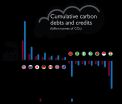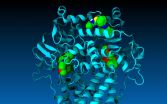(Press-News.org) This news release is available in French.
Montreal, September 8, 2015 -- All countries have contributed to recent climate change, but some much more so than others. Those that have contributed more than their fair share have accumulated a climate debt, owed to countries that have contributed less to historical warming.
This is the implication of a new study published in Nature Climate Change, in which Concordia University researcher Damon Matthews shows how national carbon and climate debts could be used to decide who should pay for the global costs of climate mitigation and damages.
The countries that have accumulated the largest carbon debts on account of higher than average per-capita carbon dioxide (CO2) emissions are the United States, Russia, Japan, Germany, Canada, the United Kingdom and Australia.
The U.S. alone carries 40 per cent of the cumulative world debt, while Canada carries about four per cent. On the other side, the carbon creditors -- those whose share of CO2 emissions has been smaller than their share of world population -- are India, Indonesia, Bangladesh, Pakistan, Nigeria, Brazil and China, with India holding 30 per cent of the total world credit.
"Thinking of climate change in terms of debts and credits for individual countries shows how much countries have over- or under-contributed to historical warming, relative to their proportion of the world's population over time," explains Matthews, study author and associate professor in Concordia's Department of Geography, Planning and Environment.
"This paints a striking picture of the historical inequalities among countries with respect to their greenhouse gas emissions and consequent responsibility for climate changes."
Calculating climate responsibility
To estimate differences in national responsibility for historical climate changes, Matthews first calculated carbon debts and credits based on fossil fuel CO2 emission and population records since 1990. It was around this date that scientific knowledge and public understanding of the dangers of human-driven climate changes began to solidify.
Since that time, the total carbon debt across all debtor nations has increased to 250 billion tonnes of carbon dioxide. And it's still going up: the increase in world carbon debt in 2013 alone was 13 billion tonnes, or about 35% of global CO2 emissions in that year.
So what is the monetary value of this debt? "According to a recent U.S. government report, the current best estimate of the social cost of present-day CO2 emissions is about $40 USD per tonne of CO2," says Matthews. "Multiply $40 by the 13 billion tonnes of carbon debt accrued in 2013, and you get $520 billion. This cost estimate gives us an indication of how much we could be paying to help lower-emitting countries cope with the costs of climate changes, or develop their economies along carbon-free pathways."
Looking at the total world carbon debt, the numbers are even more staggering: the 250 billion tonnes of debt accumulated since 1990, at $40 per tonne, represents $10 trillion USD. "No matter how you look at this picture, these numbers are really big -- much, much larger than even the most generous financial commitments currently pledged by countries to help with the cost of climate adaptation and damages in vulnerable countries."
CO2 emissions vs. degrees of debt
Matthews also calculated how much each country has over- or under-contributed to temperature increases as a result of a range of different greenhouse gas emissions. By this measure, the total accumulated world climate debt comes to 0.1 °C since 1990, close to a third of observed warming over this period of time. Again the U.S. is the single largest debtor, and India is the largest creditor. Some countries, however, like Brazil and Indonesia, switch from being carbon creditors, to being among the climate debtor countries, as a result of the additional greenhouse gas emissions produced by deforestation and agriculture.
"This idea of climate and carbon debts and credits highlight the large historical inequalities with respect to how much individual countries have contributed to climate warming," says Matthews. "The historical debts and credits calculated here could be a helpful tool to inform policy discussions relating to historical responsibility and burden sharing, by providing a measure of who should pay -- and how much they might be expected to pay -- for the costs of mitigation and climate damages in countries with lower emissions."
What does this mean for the upcoming Paris meetings?
As countries continue to announce their Intended Nationally Determined Contributions (or INDCs) leading up to December's climate talks in Paris, it is becoming increasingly clear that these emissions pledges will not be enough to meet the international goal of limiting global warming to 2°C (see related research by Matthews' research group published last month in Environmental Research Letters). The idea of additionally accounting for debts and credits would of course increase the burden placed on countries with high historical emissions. "But these historical inequalities are real and substantial, and need to be fully acknowledged," says Matthews. "My hope is that this discussion will help lead to a stronger and more meaningful global climate agreement."
INFORMATION:
Related links:
Cited study in Nature Climate Change
Related article in Environmental Research Letters
Department of Geography, Planning and Environment
Damon Matthews
Media contact:
Cléa Desjardins
Senior advisor, media relations
University Communications Services
Concordia University
Phone: 514-848-2424, ext. 5068
Email: clea.desjardins@concordia.ca
Web: http://www.concordia.ca/now/media-relations
Twitter: @CleaDesjardins
Scientists at Texas A&M University have made additional progress in understanding the process behind scar-tissue formation and wound healing -- specifically, a breakthrough in fibroblast-to-fibrocyte signaling involving two key proteins that work together to promote fibrocyte differentiation to lethal excess -- that could lead to new advances in treating and preventing fibrotic disease.
A new study led by biologists Richard Gomer and Darrell Pilling and involving Texas A&M graduate students Nehemiah Cox and Rice University technician Varsha Vakil points to a naturally ...
Contrary to popular belief, the worst injuries baseball catchers face on the field come from errant bats and foul balls, not home-plate collisions with base runners, according to findings of a study led by researchers at the Johns Hopkins University School of Medicine.
The research, done in collaboration with Baltimore Orioles trainers Brian Ebel and Richard Bancells, involved analysis of all catcher injuries during major league baseball games over a 10-year period.
A summary of the findings, published ahead of print Aug. 28 in the American Journal of Sports Medicine, ...
AUGUSTA, Ga. - The regular physical trauma that appears to put professional football players at risk for degenerative brain disease may also increase their risk for hypertension and cardiovascular disease, researchers say.
The frequent hits football players experience, particularly frontline defenders such as linemen, likely continually activate the body's natural defense system, producing chronic inflammation that is known to drive blood pressure up, according to a study in The FASEB Journal.
While strenuous physical activity clearly has its benefits, it also produces ...
Researchers at Southern Methodist University, Dallas, have discovered three new drug-like compounds that could ultimately offer better odds of survival to prostate cancer patients.
The drug-like compounds can be modified and developed into medicines that target a protein in the human body that is responsible for chemotherapy resistance in cancers, said biochemist Pia D. Vogel, lead author on the scientific paper reporting the discovery.
So far there's no approved drug on the market that reverses cancer chemotherapy resistance caused by P-glycoprotein, or P-gp for short, ...
Using "mini-brains" built with induced pluripotent stem cells derived from patients with a rare, but devastating, neurological disorder, researchers at University of California, San Diego School of Medicine say they have identified a drug candidate that appears to "rescue" dysfunctional cells by suppressing a critical genetic alteration.
Their findings are published in the September 8 online issue of Molecular Psychiatry.
The neurological disorder is called MECP2 duplication syndrome. First described in 2005, it is caused by duplication of genetic material in a specific ...
ALEXANDRIA, VA--The latest research on hearing loss, head and neck cancers, sleep apnea and other otolaryngic topics will be presented in Dallas, TX, September 27-30, at the 2015 Annual Meeting & OTO EXPO? of the American Academy of Otolaryngology--Head and Neck Surgery Foundation (AAO-HNSF), the largest annual meeting of ear, nose, throat, head and neck physicians in the world.
Abstracts of the research to be presented are now available online at http://oto.sagepub.com/content/153/1_suppl.toc. The 2015 Annual Meeting features more than 380 oral and 180 poster presentations ...
ATLANTA - September 8, 2015-New American Cancer Society Cancer Survivorship Care guidelines released today provide primary care clinicians with recommendations for providing comprehensive care to the estimated 1.2 million survivors of colorectal cancer in the United States.
The guidelines are the second to be published in a series of cancer survivorship care guidelines developed by the American Cancer Society. They provide guidance on identifying and managing potential physical and psychosocial long-term and late effects of colorectal cancer and its treatment, as well ...
PITTSBURGH, Sept. 8, 2015 - Young people across the United States who smoke electronic cigarettes are considerably more likely to start smoking traditional cigarettes within a year than their peers who do not smoke e-cigarettes, according to an analysis led by the University of Pittsburgh Center for Research on Media, Technology, and Health (CRMTH) and the Dartmouth-Hitchcock Norris Cotton Cancer Center. The study, funded by the National Cancer Institute (NCI), was the first to assess this relation in a national U.S. sample of youth, and to include people older than 18 ...
Continued smoking after a diagnosis of multiple sclerosis (MS) appears to be associated with accelerated disease progression compared with those patients who quit smoking, according to an article published online by JAMA Neurology.
MS is a neurogenerative disease and smoking is one of its known risk factors. While MS begins with an initial course of irregular and worsening relapses, it usually changes after about 20 years into secondary progressive (SP) disease. The time from onset to conversion to SPMS is a frequently used measure of disease progression.
Jan Hillert, ...
About one-third of girls and boys who survived child trafficking experienced physical and/or sexual violence during their ordeal in a study of children receiving posttrafficking services in Cambodia, Thailand and Vietnam, according to an article published online by JAMA Pediatrics.
Many of these survivors of child trafficking in the Greater Mekong Subregion of Southeast Asia screened positive for depression, anxiety and posttraumatic stress disorder (PTSD), and mental health symptoms were associated with self-harm and suicide ideation, according to the article.
Millions ...



